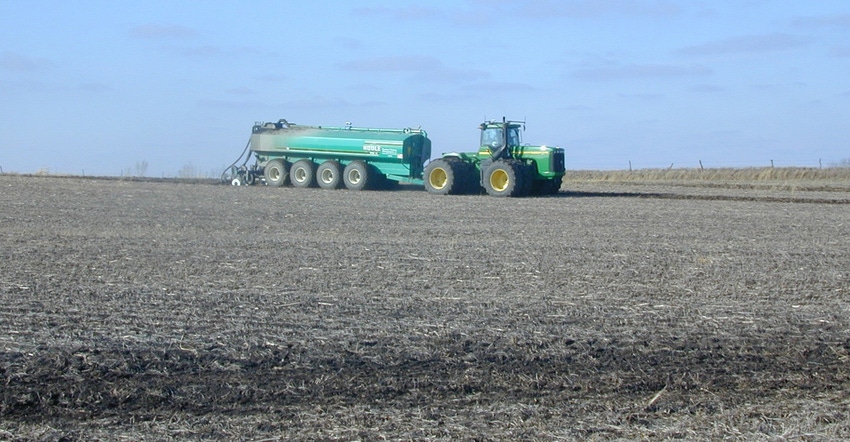November 1, 2018

By Dan Andersen
Frequent rainfall has delayed harvest across Iowa this fall, leading to concerns about whether manure application will be completed. The projected favorable forecast for the last week of October and into early November should provide an opportunity for manure application.
You need to focus on making sure there is sufficient storage capacity to make it through the winter. However, as wet weather conditions can increase nutrient transport and loss, it’s important to make sure best manure application strategies are followed to minimize negative environmental impacts and ensure producers benefit from manure fertilizer value.
More soil moisture raises risk of loss
Increased soil moisture increases both the risk of runoff and manure movement to tile lines. Higher soil moistures lead to both slower infiltrations of applied manure and greater potential for leaching. Liquid manure applications will increase soil moisture further. For example, a manure application of 13,500 gallons per acre is equivalent to a half-inch rainstorm.
There are several things producers can do to minimize risk of nutrient loss. These steps include:
• Reduce manure application rates. This may mean applying fertilizer and using manure to supplement it, or providing a second manure application in the spring to meet nutrient application goals. The soil in spring has a better chance of holding all the nutrients applied.
• Pick and choose your fields. All fields aren’t created equal. Some have more slope, some are closer to streams and rivers, and some are naturally wetter and more poorly drained. Take advantage of knowing the farm and apply in the drier locations.
• Follow the contour. Wetter soils mean the manure soaks in more slowly; the manure and those nutrients need to stay where they are put. Following the contour provides less opportunity for flow and decreases mini-micro topography, which means less runoff from the field from rainfall events shortly after manure application.
• Apply over residue. Fields with more crop residue cover will tend to have less runoff and less erosion than fields where crop residue has been removed. Take advantage of this by putting manure where crop residue cover remains.
• Increase setback. Increase setback distances from rivers, streams, lakes and sinkholes.
• Review manure management plan. Identify fields that have a low phosphorus index and apply to those first. This normally means the field is at a lower risk of nutrient loss.
• Watch the forecast. The highest risk time for nutrient transport (nutrients being lost in the field) is within the first 48 hours of manure application. Try to avoid applying if larger storms (greater than 0.5 inch of rain) are forecast.
These practices don’t eliminate risk of nutrient loss, but taking these actions can help keep the nutrients in the fields and out of Iowa’s waters.
What about soil compaction?
Wet conditions always lead to concerns and questions about soil compaction. Check tire inflation pressures, only partially fill tanks, or consider drag line application of manure to fields to reduce the compaction risk.
Good manure storage management means making sure to have sufficient capacity to make it through winter and into spring. Keep soil and weather conditions in mind and focus on actions to protect Iowa’s waters.
Andersen is an Iowa State University Extension manure management specialist.
You May Also Like




